Project Log: Monday, July 11, 2011
A 90° day in mid-July seems an odd time to consider boat
heating systems, yet that's where I ended up on this
day. I'd been considering various heating options
for a time, from simple bulkhead-mount propane or
diesel-fired units to the more expensive air and
hydronic systems from Webasto and Espar.
Early on, I'd eliminated diesel-fired stand-alone
heaters (i.e. Dickinson, Refleks, Sig Marine) from
contention as I didn't have the room to spare, and would
have difficulty providing the requisite stack heights
for these units.
Similarly, I soon discounted bulkhead-mount
propane-fired heaters like the Dickinson Newport from
consideration as I felt again that the boat's layout
didn't really offer the bulkhead space to spare for one
of these units, at least not without compromises I was
unwilling to make.
This led me down the road towards the small diesel-fired
Webasto and
Espar forced air heaters. In many ways, these
solved the problems I faced, but I had to sort through
the usual accolades and criticism on the Internet to
attempt to gain a clear picture of these units'
reliability and utility. These were still under
consideration.
During an offhand conversation with a friend, I learned
of a heater I'd never heard of, called a
Hurricane Heater. Searching online, I soon
found the information I needed, and felt these
units--hydronic, rather than forced air--had some
potential. In particular, I was interested in the
Hurricane Combi unit, which combined diesel-fired
hydronic (forced hot water) heating with domestic hot
water capability, all in one package. I liked the
idea of this since it could mean we could have domestic
hot water at anchor without needing to run the engine
(typical domestic water heaters are fired by
120VAC--unusable without a shoreside connection--or
engine coolant bypass).
The problem with the Hurricane unit was that it was
relatively bulky, with specific clearance and access
requirements for the rectangular unit. With limited
space available for such an installation, the first
order of business was to determine whether I could
conceivably fit the unit.
From the beginning, I'd planned on installing a
traditional water heater in the engine room, in an open
space on the aft port side behind the new saddle tanks
and outboard of the center fuel tank beneath the
cockpit. There was adequate space here for one of
several brands of 120VAC/coolant-bypass water heaters on
the market. The question now was whether this
space was large enough for the Hurricane Combi, which
had base dimensions of 23" x 16" x 14". |
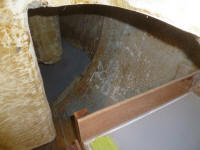
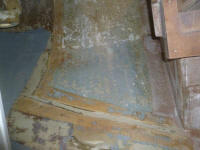
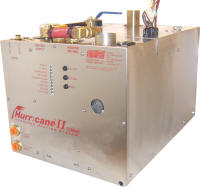 |
With measuring tape in hand, I measured up the space
available, and quickly determined that at best, the
clearances were close. This led me to build a
quick cardboard mockup of the unit. |
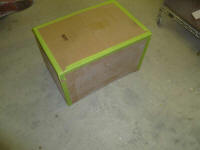 |
At some point during the mockup construction, I started
to wonder whether there were additional space clearances
required for this unit (I remembered a requirement for a
certain clear access to the front panel), and also
whether the dimensions I'd noted on a scrap of paper a
couple weeks earlier during my initial research included
the various plumbing and exhaust fittings on the top of
the unit. I thought I'd better double check this
online; I immediately discovered that an additional 6"
space was required in addition to the 14" height of the
base unit, which completely eliminated it from
consideration since my early engine room measurements
had suggested that the unit itself might not even fit
(which is why I'd started the mockup).
This was disappointing, as I'd been excited at the
possibility of combining my heat and domestic hot water
in this way. However, this forced me to spend more
time researching the alternatives, which included both
forced air and hydronic units from Espar and Webasto.
Specifically the
Air Top 3900 forced air and
Thermotop C/E hydronic heaters from Webasto: |
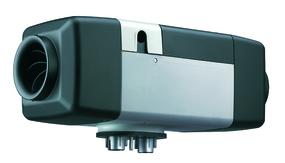
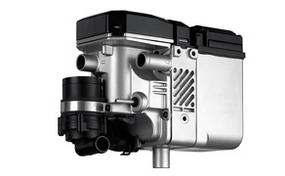 |
Or the
Hydronic M10 and
Airtronic 4 from Espar: |
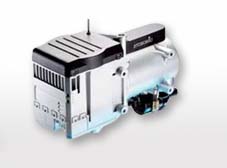
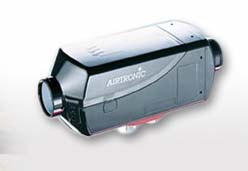 |
The advantage of the hydronic units was that it would be
possible to heat domestic hot water as well (at least
with the Webasto Thermotop). Otherwise, I'd still
require a regular water heater (current units under
consideration were the 6-gallon versions by Isotemp and
Superstor), which use would be somewhat restricted at
anchor since it would require the engine to have been
run relatively recently to heat the water. This
would not pose a problem on travel days, but for lay
days in port it might. We didn't anticipate much
if any time dockside where we could heat the water with
AC power, so needed to take at-anchor usage into
consideration.
I found the manufacturers' websites (Espar in
particular) to be confusing, contradictory, and
difficult to sift through in order to determine the best
choices, so as of this writing the research continued as
I tried to make the basic choice in the near future, to
be sure I accounted for the heating system's
requirements, ducting, piping, fuel, exhaust, and other
considerations. |
| |
Total Time Today: 2 hours
|
<
Previous | Next > |
|
|









